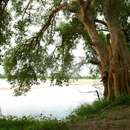en
names in breadcrumbs


Ficus sycomorus, called the sycamore fig or the fig-mulberry (because the leaves resemble those of the mulberry), sycamore, or sycomore, is a fig species that has been cultivated since ancient times.
The term sycamore spelled with an A has also been used for unrelated trees: the great maple, Acer pseudoplatanus, or plane trees, Platanus. The spelling "sycomore", with an O rather than an A as the second vowel is, if used, specific to Ficus sycomorus.[2][3]
Ficus sycomorus is native to Africa south of the Sahel and north of the Tropic of Capricorn, also excluding the central-west rainforest areas. It also grows naturally in Lebanon; in the southern Arabian Peninsula; in Cyprus; in very localised areas in Madagascar; and in Israel, Palestine and Egypt. In its native habitat, the tree is usually found in rich soils along rivers and in mixed woodlands.
Ficus sycomorus grows to 20 m tall and has a considerable spread, with a dense round crown of spreading branches. The leaves are heart-shaped with a round apex, 14 cm long by 10 cm wide, and arranged spirally around the twig. They are dark green above and lighter with prominent yellow veins below, and both surfaces are rough to the touch. The petiole is 0.5–3 cm long and pubescent. The fruit is a large edible fig, 2–3 cm in diameter, ripening from buff-green to yellow or red. They are borne in thick clusters on long branchlets or the leaf axil. Flowering and fruiting occurs year-round, peaking from July to December. The bark is green-yellow to orange and exfoliates in papery strips to reveal the yellow inner bark. Like all other figs, it contains a latex.
According to botanists Daniel Zohary and Maria Hopf, cultivation of this species was "almost exclusively" by the ancient Egyptians.[4]: 130 Remains of F. sycomorus begin to appear in predynastic times and occur in quantity from the start of the third millennium BC. It was the ancient Egyptian Tree of Life.[5] Zohary and Hopf note that "the fruit and the timber, and sometimes even the twigs, are richly represented in the tombs of the Egyptian Early, Middle and Late Kingdoms."[4]: 131 In numerous cases the parched fruiting bodies, known as sycons, "bear characteristic gashing marks indicating that this art, which induces ripening, was practised in Egypt in ancient times."[4]: 131
Although this species of fig requires the presence of the symbiotic wasp Ceratosolen arabicus to reproduce sexually, and this insect is extinct in Egypt, Zohay and Hopf have no doubt that Egypt was "the principal area of sycamore fig development."[4]: 131 Some of the caskets of mummies in Egypt are made from the wood of this tree. In tropical areas where the wasp is common, complex mini-ecosystems involving the wasp, nematodes,[6][7] other parasitic wasps, and various larger predators revolve around the life cycle of the fig. The trees' random production of fruit in such environments assures its constant attendance by the insects and animals which form this ecosystem.
A study in 2015 indicated that the sycamore tree was brought to Israel by Philistines during the Iron Age, along with opium poppy and cumin.[8][9] These sycamore trees used to be numerous in western Beirut, lending their name to the neighborhood of Gemmayzeh ((الْجُمَّيْزَة al-Ǧummayzah), "sycamore fig").[10] However, the trees have largely disappeared from this area.[11]
In the Near East F. sycomorus is an orchard and ornamental tree of great importance and extensive use. It has wide-spreading branches and affords shade.
In the Bible, the sycomore is referred to seven times in the Old Testament (Hebrew שִׁקְמָה shiḳmah; Strong's number 8256) and once in the New Testament (συκομoραία sykomoraia or συκομορέα sykomorea;[12] Strong's number 4809). The sycomore was a popular and valuable fruit tree in Jericho and Canaan.[13]
In Kikuyu religion, the sycomore is a sacred tree. All sacrifices to Ngai (or Murungu), the supreme creator, were performed under the tree. Whenever the mugumo tree fell, it symbolised a bad omen and rituals had to be performed by elders in the society. Some of those ceremonies carried out under the Mugumo tree are still observed.[14][15]
Ficus sycomorus, called the sycamore fig or the fig-mulberry (because the leaves resemble those of the mulberry), sycamore, or sycomore, is a fig species that has been cultivated since ancient times.
The term sycamore spelled with an A has also been used for unrelated trees: the great maple, Acer pseudoplatanus, or plane trees, Platanus. The spelling "sycomore", with an O rather than an A as the second vowel is, if used, specific to Ficus sycomorus.